Red is an attention-grabbing color associated with love and passion and symbolizes action, anger, adventure, and energy.
That’s why birds that have red plumage have always been very popular, especially those large ones.
Examples of big red birds include the scarlet ibis, red-and-green macaw, Eclectus parrot, scarlet macaw, American flamingo, golden pheasant, and many others.
Here are their photos, identification info, sizes, calls, and all the fun information you need.
Table of Contents
Big Red Birds
Red Lory
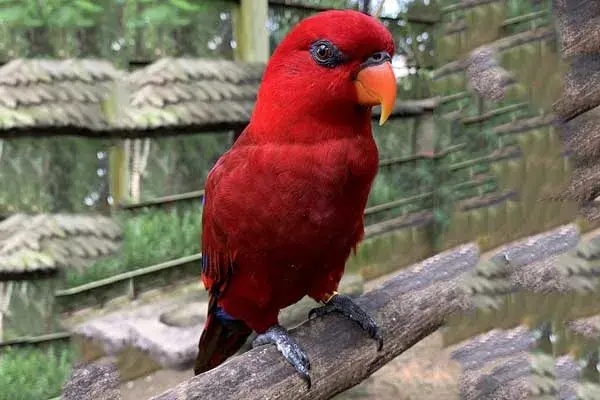
- Scientific Name: Eos bornea
- Lifespan: 15- 30 years
- Wingspan: 6.7 in
- Length: 12 in
- Weight: 0.4-0.66 lb
Red lories are the second most popular pet lory species in the world, after rainbow lorikeets.
They are found in Australia, Indonesia, New Guinea, and the Indonesian Maluku Islands; they inhabit tropical moist lowland forests and tropical mangrove forests.
Red lories are red birds with almost completely pomegranate-red plumage; they also have some blue markings on their wings and faces.
Their beaks are orange and their feet are gray.
These very intelligent and highly active birds love to talk and will always make noise and thrash their toys in the cage.
They are omnivores and in the wild, have a diet consisting of nectar, pollen, fruits, and occasional insects.
Despite not being the biggest in the world, red lories still measure around 12 inches long and can weigh up to 10.5 ounces.
Read More: More examples of orange-billed birds
Scarlet Ibis
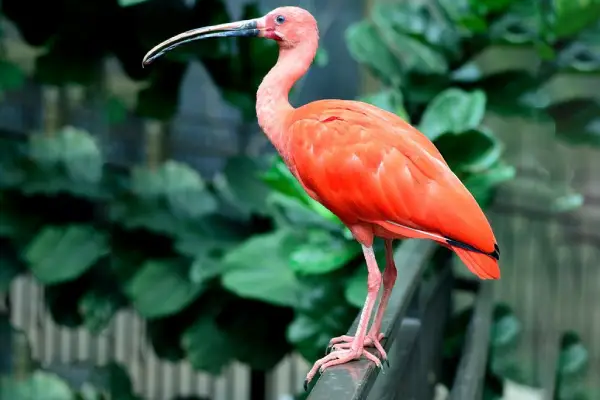
- Scientific Name: Eudocimus ruber
- Lifespan: 32 years
- Wingspan: 21 in
- Length: 22-25 in
- Weight: 3.1 lb
Scarlet ibises are large birds native to South America and parts of the Caribbean Islands.
They can be recognized by their long pink legs and necks, partially webbed feet, and downcurved beaks that are 6-7 inches long.
As the name suggests, scarlet ibises are birds that are bright red (scarlet) colored. Their plumage can have different shades of red, pink, and orange; the wing tips are black.
Scarlet ibises were introduced to Florida and can now be seen year-round around marshes, swamps, inland wetlands, lawns, and shallow ponds of its southern parts.
They can be often spotted wading in shallow waters, probing mud and vegetation with their sensitive beaks in pursuit of food.
These big red birds get their brilliant red color from carotenoids found in the crustaceans they consume.
Their diet also includes mollusks, fish, insects, frogs, and small snakes.
Despite spending most of their time wading and walking on the ground, scarlet ibises are great fliers, highly migratory, and can cross long distances. They can be spotted in groups of 30 and more, flying in a classic V formation.
Scarlet ibises are the national birds of Trinidad and Tobago.
If you are interested in seeing more long-billed birds found in Florida, check this article.
Crimson Rosella

- Scientific Name: Platycercus elegans
- Lifespan: 25 years
- Wingspan: 17-21 in
- Length: 11.8-14.6 in
- Weight: 0.22-0.35 lb
Crimson rosellas are medium-large red parrots found in eastern and southeastern Australia, around mountain forests, farmlands, pastures, parks, and gardens.
They breed there from September to January and have a clutch of 3-8 white and shiny eggs.
There are 7 subspecies of crimson rosellas; three of those are bright red.
They have very long tails, overall red plumage with rich blue wings, blue cheeks, pale gray beaks, and dark brown eyes.
These birds can be conspicuous and noisy, especially when foraging.
Crimson rosellas feed on plants, especially seeds, nuts, berries, fruits, some insects, and insect larvae. They can be even attracted to garden seed trays.
Once familiar with humans, they will even accept hand-held food.
They can’t talk like macaws, but they can mimic whistles and songs.
Scarlet Macaw
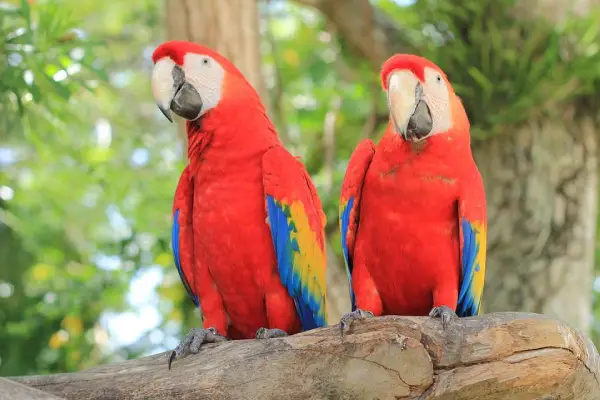
- Scientific Name: Ara macao
- Lifespan: 40-50 years
- Wingspan: 39 in
- Length: 32 in
- Weight: 2.2 lb
Scarlet macaws are one of the biggest red parrots in the world.
They span around 3.3 ft across the wings, measure 2.75 ft in length, and weigh around 2.3 lbs.
Their striking plumage makes them one of the most popular birds in aviculture.
Scarlet macaws are mostly bright red with blue rumps and tail-covert feathers, dark blue wings, and yellow upper wing coverts.
They also have white skin around their eyes and pale horn-and-black beaks.
These parrots can live a long life, typically from 40 to 50 years; some manage to survive for 90 years!
Scarlet macaws are the national birds of Honduras and they breed in lowland rainforests and semiopen areas with big trees in Central and Southern America.
They can be seen in countries like Mexico, Bolivia, Peru, Ecuador, Colombia, Brazil, and Venezuela.
During their breeding period, they become extremely aggressive. Scarlet macaws are monogamous birds that stay together for life.
They are also omnivores and feed on fruits, nuts, seeds, flowers, fruit nectar, insects, and larvae.
Scarlet macaws are very intelligent birds that can mimic human speech and will often make loud throaty squawks, squeaks, and screams to communicate with their group in the wild.
They are just one of many colorful examples of birds found in the tropics.
Australian King Parrot

- Scientific Name: Alisterus scapularis
- Lifespan: 25 years in captivity
- Wingspan: 18 in
- Length: 17 in
- Weight: 0.7 lb
Australian king parrots are large birds endemic to eastern Australia.
They inhabit humid regions with lots of trees, ranging from north and central Queensland to southern Victoria.
These parrots measure 17 inches in length and span around 18 inches across the wings.
Australian king parrots have bright red heads, breasts, and underparts, green wings, green tails, and blue rumps. Females are greener than males.
These birds are herbivores and consume fruits and seeds from trees or the ground.
Australian king parrots can be often found in small groups with other birds like the slightly larger crimson rosellas.
Their balanced personality and relative quietness make them decent pets.
They are not as “talkative” as other parrots but still can form great bonds with their owners.
Eclectus Parrot
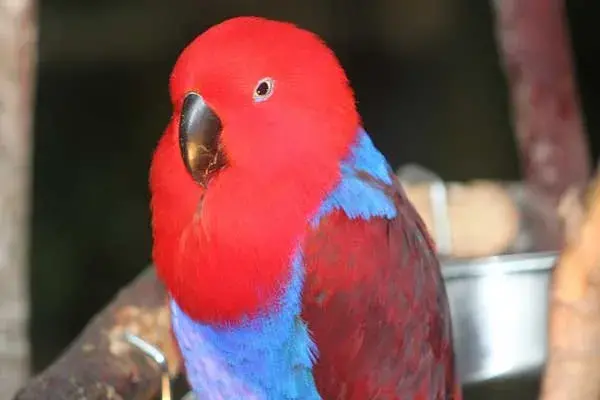
- Scientific Name: Eclectus roratus
- Lifespan: 30-50 years
- Wingspan: 34-35 in
- Length: 13-16 in
- Weight: 1.1-1.4 lb
Eclectus parrots are parrots native to the Solomon Islands, Australia, Indonesia, the Moluccas, and New Guinea.
They have a lot bigger wingspan than Australian king parrots; they span around 2.9 ft across the wings and can weigh up to 1.4 pounds.
They are one of the most sexually dimorphic species with males and females being completely differently colored.
Female Eclectus parrots are bright red and with blue bellies and underwings; males are bright green with blue underwings.
Recognize them by their large heads, short tails, yellow-orange eyes, and stunning plumage.
Because of those differences, until the 20th century, people considered them to be separate species.
A healthy male Eclectus parrot will have a bright orange beak – this means that the bird is in good condition.
They are shy birds that are active during the day and spend most of their time collecting food, eating, and resting. They are also omnivores that mostly feed on fruits, seeds, figs, nuts, and flowers in the wild.
Eclectus parrots are great at mimicking human speech and can produce various sounds, including tones, coos, whistles, and laughs.
Red-and-green Macaw
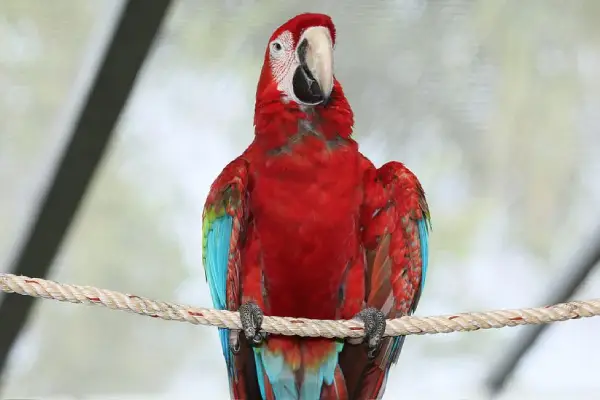
- Scientific Name: Ara chloropterus
- Lifespan: 50 years in captivity
- Wingspan: 41-49 in
- Length: 35-37 in
- Weight: 2.3-3.7 lb
Red-and-green macaws are the second-largest macaw species in the world, larger even than scarlet macaws.
The largest one is the hyacinth macaw, one of our many examples of the world’s largest blue birds.
Red-and-green macaws resemble scarlet macaws – the main differences are the size, green upper-wing coverts in red-and-green macaws (yellow in scarlet macaws), and red lines around the bare white skin patches in red-and-green macaws.
Speaking of appearance, red-and-green macaws have long pointed tails, red heads and bodies, and mainly blue wings and green wing coverts.
Also known as the green-winged macaws, these enormous red birds are commonly found in forests and woods of northern and central parts of South America.
Their stunning looks have made them popular among poachers; such illegal trade and habitat loss have made their numbers decline in recent years.
According to some estimates, there are 50,000-100,000 of these birds in the wild today.
Red-and-green macaws are monogamous and mate for life. They nest in tree holes and have a clutch of 2-3 eggs that the female incubates.
Identify them also by their raucous calls that are common with large macaws.
Roseate Spoonbill
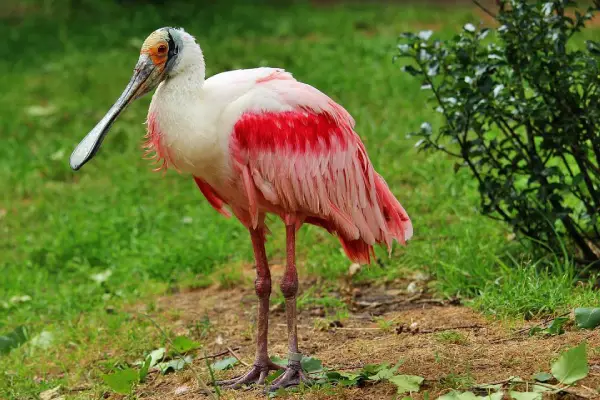
- Scientific Name: Platalea ajaja
- Lifespan: 10-15 years
- Wingspan: 47-52 in
- Length: 28-34 in
- Weight: 2.6-4 lb
Roseate spoonbills are unique big birds found in South and North America.
In the USA, they are permanent residents of Southern Florida and Southern Texas.
Roseate spoonbills have deep pink plumage and blazes of carmine red on the wings and necks.
They are also easy to recognize by extremely long spoon-shaped beaks and featherless heads.
Just like scarlet ibises, roseate spoonbills get their pink-red color from consuming crustaceans and other aquatic invertebrates that are full of carotenoids.
Mainly quiet until the breeding season comes, roseate spoonbills will make low grunting sounds or faint rattling sounds by clicking their beaks together.
They are common in groups, foraging in the shallows of fresh and saltwater, often with egrets and ibises nearby.
They are carnivores that eat crustaceans, aquatic insects, frogs, newts, and very small fish.
Roseate spoonbills build their nests in dense mangroves or trees and lay 2-5 whitish eggs with brown marks.
Similar to humans, these birds will lose feathers from the top of their heads as they get older.
Golden Pheasant

- Scientific Name: Chrysolophus pictus
- Lifespan: 5-6 years in the wild
- Wingspan: 28 in
- Length: 35-41 in
- Weight: 1.4 lb
Also known as Chinese or rainbow pheasants, these large gamebirds are native to forests of western China.
Europe, North, and South America also contain some feral populations of these birds.
Golden pheasants can measure up to 3.4 ft in length, span around 28 inches across the wings, and weigh around 1.4 pounds.
Males have rusty red faces, throats, chins, and necks; on their heads, there are golden-yellow crests with a light tinge of red at the tip. Females have duller mottled brown colors.
Both sexes have yellow legs and yellow beaks.
These large birds aren’t known for their flying skills and will forage on the ground, feeding on grain, leaves, and invertebrates.
Their beautiful plumage makes them very popular; capture for the pet trade, overhunting for food, and timber extraction have reduced their numbers in the wild.
When the breeding season comes, male golden pheasants will often emit metallic calls.
Their scientific name “Chrysolophus pictus” comes from the Greek word “khrusolophos” meaning “with golden crest” and Latin “pingere” meaning “painted”.
American Flamingo

- Scientific Name: Phoenicopterus ruber
- Lifespan: 20-30 years
- Wingspan: 59 in
- Length: 47-57 in
- Weight: 4.9-6.2 lb
American flamingos are giant wading birds found in South and North America.
They can be identified by their very long necks, pink legs, and large hooked pink and white beaks with black tips that are curved down.
American flamingos are pink-red with red wing coverts and black primary and secondary flight feathers.
In the USA, American flamingos can be found in South Florida and the Florida Keys. The best time to see them there is from March to May, although some populations might stay in Florida Bay year-round.
They mostly inhabit saline lagoons, mudflats, and shallow, brackish coastal or inland lakes.
Their call sounds like a goose honking.
American flamingos are also named “rosy flamingos” and get their color from the food they eat, shrimp, mollusks, and brine flies; these birds are omnivores and also consume some grass, seeds, and algae.
They will often wade through shallow waters, stirring up mud with their bills and feet and driving out the prey.
After becoming completely extirpated from Florida by the 1900s, these big red birds have been reclaiming their lost range and increasing in numbers.
Great Frigatebird

- Scientific Name: Fregata minor
- Lifespan: up to 40 years
- Wingspan: 81-91 in
- Length: 33-41 in
- Weight: 2.7-3.5 lb
Great frigatebirds are big seabirds that measure up to 3.4 ft long, span 7 ft 7 in across the wings, and weigh as much as 3.5 lbs.
Females tend to be bigger than males.
Despite having black plumage, great frigatebirds have striking red gular sacs they inflate to attract females, making them appear completely red from distance!
As part of the courtship ritual, great frigatebirds will also clatter their beaks, wave heads and wings, and males will call to females while flying overhead.
These large birds have the highest ratio of wing area to body mass and the lowest wing loading of any bird.
Great frigatebirds are seasonally monogamous and stay together for a season.
They are rather cheeky and will often steal fish and other food from other seabirds. They chase and harass other birds, make them regurgitate their food, and then swoop in and catch the food in the air.
Read More: More examples of stunning red and black birds
Blue-streaked Lory
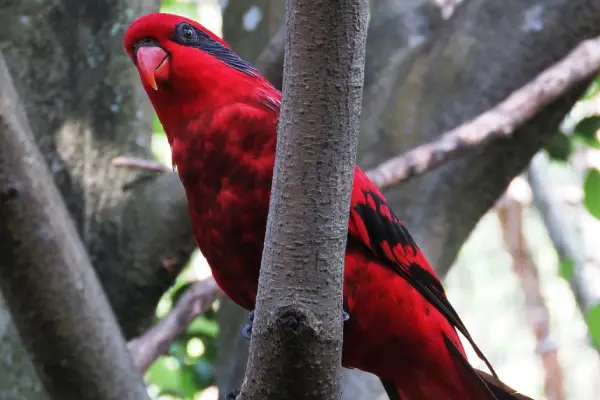
- Scientific Name: Eos reticulata
- Lifespan: 15-30 years in the wild
- Wingspan: n/a
- Length: 12 in
- Weight: 0.33 lb
Blue-streaked lories, also known as the blue-necked lories, are parrots native to the Maluku Islands in Indonesia.
These big red birds can measure around 12 inches in length and weigh up to 5.5 ounces.
Both sexes look alike – this means they are sexually monomorphic.
Blue-streaked lories are bright red and have blue streaks on their mantles and behind the necks. Notice the red tails, orange beaks, and gray feet.
They are herbivores and their diet consists of fruit, seeds, grain, pollen, buds, and nectar.
Blue-streaked lories have hair-like structures on the ends of their tongues that help pick up nectar more easily. That’s why many people refer to them as “brush-tongued parrots”.
Very active and noisy, blue-streaked lories are commonly found in large groups, together with other parrots.
People describe their call as a shrill series of screeches.
Satyr Tragopan
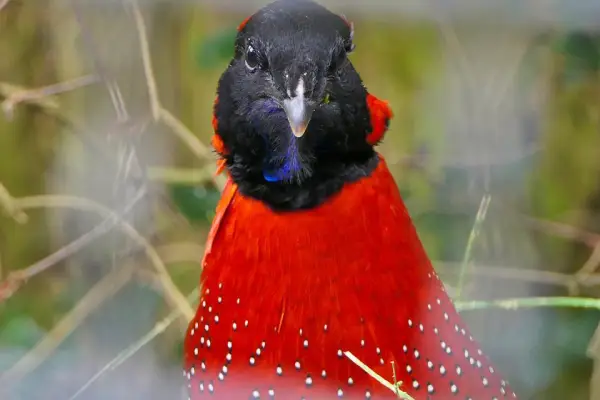
- Scientific Name: Tragopan satyra
- Lifespan: up to 21 years in captivity
- Wingspan: n/a
- Length: 28 in
- Weight: 2.2-4.6 lb
Satyr tragopans, also known as crimson-horned pheasants, are large red birds found in Asia.
They inhabit moist oak forests and bamboo clumps of India, Tibet, Nepal, and Bhutan.
Male satyr tragopans are mostly red and have some blue, black and white spots; females are brown.
They were named “satyrs” after a Roman deity often depicted with horns, due to the blue horns males grow during the breeding season.
As part of their courtship ritual, they inflate their horns, “dance” for females, and show off their ornaments.
They forage on the ground and feed on insects, spiders, fruits, and berries.
Satyr trogopans use nasal “gwaahh” calls to communicate.
Summary
This concludes our list of big red birds.
Examples include different types of parrots, ibises, spoonbills, flamingos, etc.
Next time, should you see these birds in person, you should be able to recognize any of them with ease!
And if you enjoyed our article, here are our other popular reads on birds: